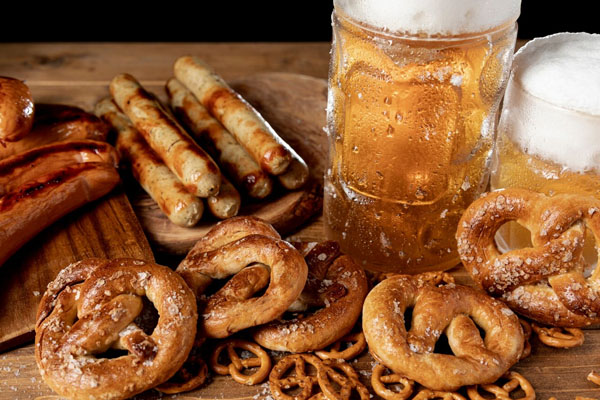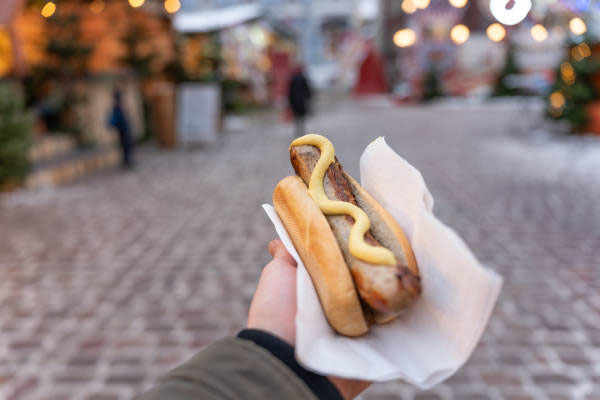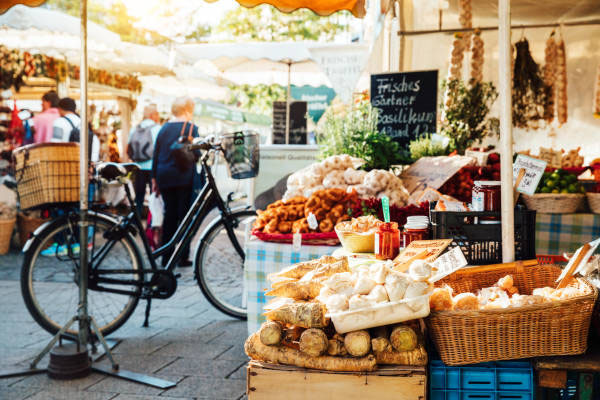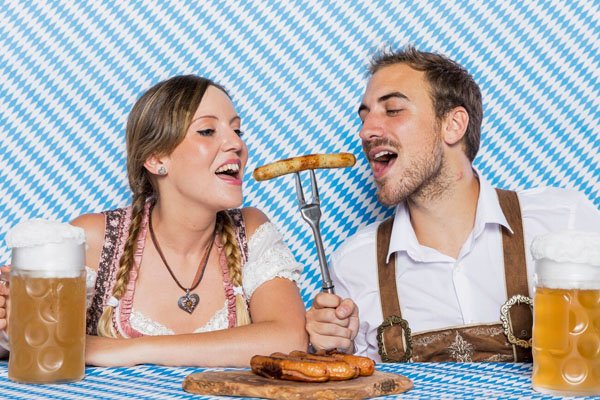Welcome to the ultimate guide on German cuisine for tourists! Embark on a culinary journey that goes beyond sausages and beer. Here, we delve into the heart of Germany’s food culture, showcasing traditional dishes, regional specialties, and modern twists that await your taste buds. Get ready to explore the rich flavors and diverse dining experiences that German cuisine has to offer.
German Cuisine
Germany’s culinary landscape offers much more than its world-renowned sausages and pretzels. Each region boasts its unique flavors, making German cuisine a diverse and exciting adventure for tourists. From the hearty stews of the south to the fresh seafood of the north, there’s a dish to satisfy every palate. This journey into German food culture reveals the country’s rich history and culinary innovation.
Moreover, German cuisine for tourists isn’t just about what’s on the plate; it’s about the experience. Imagine sitting in a bustling beer garden, a cold brew in hand, surrounded by the lively chatter of locals and fellow travelers. Or picture yourself in a cozy, candlelit restaurant, savoring a dish that has been perfected over generations. These moments create a deeper appreciation for Germany’s culinary traditions and the stories behind them.
Finally, German food culture embraces both tradition and modernity. While classic dishes like Schnitzel and Sauerbraten remain staples, contemporary chefs are putting innovative spins on these favorites, introducing global tourists to a new era of German cuisine. Vegetarian and vegan options are also increasingly available, ensuring everyone can enjoy the culinary delights Germany has to offer. This blend of the old and new makes every meal an exploration worth savoring.
Traditional German Dishes You Can’t Miss

Embarking on a culinary tour of Germany, one quickly discovers that traditional German dishes are the soul of the country’s cuisine. From succulent Schweinshaxe (pork knuckle) to flavorful Sauerbraten (marinated beef), these recipes have been passed down through generations. Each dish tells a story, offering tourists a taste of Germany’s rich history and cultural diversity. Moreover, these meals are often accompanied by hearty sides like Spätzle (egg noodles) or Rotkohl (red cabbage), rounding out a truly authentic experience.
Additionally, no exploration of German cuisine for tourists would be complete without mentioning the iconic Bratwurst. Served with a dollop of mustard and a side of sauerkraut, this simple yet delicious sausage encapsulates the essence of German food culture. It’s a must-try for anyone wanting to dive into the flavors that define this nation. Furthermore, local variations of the Bratwurst provide a delicious excuse to travel from region to region, savoring the unique tastes of each area.
Finally, for those with a sweet tooth, Germany offers a plethora of desserts that are as rich in flavor as they are in history. The Black Forest Cake, with its layers of chocolate sponge cake, whipped cream, and cherries, is a decadent treat that has gained worldwide fame. Equally delightful are the lesser-known but equally delicious treats like Apfelstrudel and Marzipan. These sweets not only conclude a meal on a high note but also reflect Germany’s longstanding tradition of baking, which tourists will find both comforting and indulgent.
Beer Gardens in Germany: More Than Just Beer

Germany’s beer gardens are iconic, offering a glimpse into the social fabric of the country. These communal spaces are not just about enjoying a pint; they’re about bringing people together. Under the shade of chestnut trees, locals and tourists alike share stories, laughter, and, of course, great beer. This tradition of gathering in beer gardens highlights the German approach to leisure—relaxed, open, and friendly. It’s a must-experience aspect of visiting Germany.
Furthermore, visiting a beer garden is a culinary adventure in itself. Beyond the vast selection of beers, ranging from crisp Pilsners to robust Dunkels, there’s a wide array of German cuisine to sample. Pretzels, Obatzda (a Bavarian cheese delicacy), and various sausages make the perfect accompaniments to your drink. This combination of flavors makes each visit unique and memorable, offering more than just a taste of Germany’s famous brews.
Lastly, beer gardens in Germany are a testament to the country’s rich brewing history. Many gardens are attached to breweries that have been perfecting their craft for centuries. Tourists can often take guided tours to learn about the brewing process before settling down to enjoy the fruits of this labor. This immersive experience connects visitors with the ancient traditions of German brewing, making it a highlight of any trip to Germany.
The Heart of German Food Culture
Delving into the heart of German food culture, one finds a world rich with tradition, quality, and communal values. Central to this culture is the importance of sharing meals, whether with family at home or with new friends in communal dining settings. This practice not only nourishes the body but also strengthens bonds between individuals, showcasing the deeply social nature of mealtime in Germany. It’s a vibrant testament to the country’s emphasis on togetherness and tradition.
Moreover, the diversity within German food culture is astonishing. Each region contributes its unique dishes and flavors, from the seafood-rich menus of the North to the hearty, meat-based fare of the South. This diversity allows tourists to embark on a gastronomic tour within the country itself. Sampling regional specialties becomes a journey of discovery, revealing the multifaceted nature of Germany through its cuisine. This exploration enriches the travel experience, offering insights into regional identities and histories.
Lastly, sustainability and quality are pillars of German food culture. Farmers’ markets and organic food shops are staples in many communities, reflecting a widespread commitment to fresh, locally sourced ingredients. This emphasis on quality extends to the country’s beer and wine production, which adheres to strict purity laws. For tourists, this means that every meal, every sip of beer or wine, is an experience in high-quality, sustainable consumption, deeply rooted in German tradition.
Snacking German Style: Popular Bites On the Go
In Germany, snacking is an art form, with street vendors and local markets offering a plethora of quick bites that are as delicious as they are convenient. From the crispy, golden Schnitzel sandwich to the savory delight of a freshly baked Brezel (pretzel), these snacks are perfect for tourists looking to savor German flavors without a sit-down meal. Each snack tells a story of tradition and taste, making them a must-try for every visitor.
Moreover, the beloved Currywurst stands out as a quintessential German snack. A steamed, then fried sausage cut into slices and doused in a curry ketchup sauce, served with a side of fries, it’s a flavor explosion not to be missed. This iconic dish symbolizes Germany’s post-war culinary innovation and has become a staple of German street food culture. It’s a simple yet profound way for tourists to connect with Germany’s modern history through cuisine.
Lastly, for those with a sweeter palate, Germany offers an array of traditional pastries and sweets that are perfect for on-the-go indulgence. From the decadent Schneeballen (snowball) pastries of Rothenburg to the rich, creamy Berliner doughnuts, these treats are not only a delight to the senses but also offer a glimpse into the local baking traditions. Sampling these sweets provides a delightful pause in your day, allowing for a moment of sweetness amidst the hustle and bustle of exploring Germany.
Regional Specialties: A Taste of Germany’s Diversity
Germany’s culinary map is as varied as its landscapes, with each region boasting its own signature dishes that tourists must explore. In the north, fresh seafood dominates the menus, while the south offers hearty, meat-based dishes like Schweinshaxe. This diversity not only enriches the gastronomic experience but also mirrors the cultural distinctions within Germany. It’s a delightful way for tourists to understand the country’s regional identities through taste.
Moreover, the wine regions of Germany, such as the Mosel and Rheingau, offer more than just exquisite wines. They introduce visitors to local specialties like Riesling-infused dishes and the Palatinate’s Saumagen. This blend of culinary and vinicultural excellence provides a unique dining experience, showcasing the harmonious relationship between local food and wine. It’s an exploration that promises to delight the palate and deepen appreciation for Germany’s regional flavors.
Lastly, exploring regional specialties means uncovering hidden gems like Thuringian Bratwurst, distinct from its counterparts for its unique blend of spices, or the Black Forest’s Schwarzwälder Kirschtorte, a cake that has become a symbol of German confectionery art. These specialties not only offer a taste of local tradition but also a sense of place, making them essential experiences for tourists wanting to delve into the heart of German cuisine.
Street Food in Germany: A Delicious Exploration

Germany’s street food scene offers an exciting and accessible way for tourists to taste the country’s culinary diversity. From bustling Christmas markets serving Glühwein and roasted nuts to summer festivals featuring Bratwurst and Fischbrötchen, there’s always something new to discover. This exploration allows visitors to experience German culture authentically, as they enjoy flavors that have been beloved by locals for generations, all within the lively atmosphere of Germany’s streets.
Additionally, the street food in Germany goes beyond traditional fare, incorporating influences from around the world. Döner kebabs, originally from Turkey but now a staple in German fast food, showcase the country’s multicultural landscape. Similarly, international food trucks and markets offer everything from Asian to Latin American cuisines, reflecting Germany’s open and diverse society. For tourists, this means a plethora of options, ensuring that every culinary preference and curiosity can be satisfied.
Lastly, the innovation in Germany’s street food scene is noteworthy. Food festivals in cities like Berlin and Hamburg introduce visitors to the latest trends, from vegan snacks to gourmet burgers. These events are not just about food; they’re celebrations of creativity, sustainability, and community. For tourists, participating in these festivals offers a taste of Germany’s forward-thinking culinary scene, making street food an essential part of the travel experience.
Sweet Treats: German Desserts to Die For
In Germany, desserts are not just an afterthought but a pivotal part of the dining experience. The country’s bakeries, cafes, and restaurants take pride in offering a wide array of sweet treats that reflect Germany’s rich culinary heritage. From the internationally beloved Black Forest Cake to the less well-known but equally delicious Baumkuchen, these desserts are a testament to the skill and creativity of German bakers.
Moreover, the tradition of Kaffee und Kuchen (coffee and cake) in the afternoon is a delightful German custom that offers a pause for sweetness and relaxation in the day. This practice allows tourists and locals alike to savor exquisite pastries like the Streuselkuchen (crumble cake) or the creamy, fruity delight of a well-made Käsekuchen (cheesecake). These moments of indulgence are not just about the flavors but also about embracing the German way of life, which values leisure and enjoyment.
Lastly, seasonal specialties add a layer of excitement to exploring German desserts. During the Christmas season, markets and bakeries overflow with treats like Stollen, a rich, fruit-laden bread, and Lebkuchen, a spiced gingerbread cookie that dates back centuries. These seasonal delights, deeply embedded in tradition, offer a taste of Germany’s festive spirit and culinary ingenuity. Sampling these treats provides a sweet conclusion to any meal and a deeper appreciation for Germany’s culinary traditions.
Navigating Dining Etiquette in Germany
Understanding dining etiquette is crucial for tourists looking to immerse themselves fully in the German dining experience. From the moment you sit down at a table, certain norms and practices enhance the meal’s enjoyment. For instance, it’s customary to wait for everyone to be served before starting to eat. This practice reflects the communal aspect of dining in Germany, emphasizing respect and consideration for fellow diners.
Moreover, toasting is a beloved tradition in German gatherings, especially when enjoying beers or wines. “Prost!” or “Zum Wohl!” are the common toasts, accompanied by eye contact, signifying trust and camaraderie. This simple act connects diners, creating a moment of shared goodwill. Additionally, using utensils properly, with the fork in the left hand and the knife in the right, showcases respect for the local dining culture and enhances the eating experience.
Lastly, tipping in Germany, while not mandatory, is a sign of appreciation for good service. Rounding up the bill or leaving a 5-10% tip is customary and greatly appreciated by servers. This gesture of gratitude closes the dining experience on a positive note, reflecting the visitor’s respect for German customs and the service received. Navigating these dining etiquettes not only enriches the culinary journey but also fosters a deeper connection with German culture.
Vegetarian and Vegan Delights in German Cuisine
German cuisine, traditionally known for its hearty meats and sausages, is evolving to include a plethora of vegetarian and vegan options. Cities across Germany are embracing this shift, offering a wide variety of dishes that cater to plant-based diets. From vegan versions of the classic Schnitzel made with seitan or tofu to vegetarian Döner kebabs, the options are deliciously diverse. This evolution reflects Germany’s growing commitment to sustainability and health-conscious dining.
Moreover, many traditional German soups and salads have always been vegetarian-friendly, such as the flavorful Linsensuppe (lentil soup) or the refreshing Gurkensalat (cucumber salad). These dishes, often overlooked in favor of more robust fare, provide a lighter yet equally satisfying taste of German culinary culture. Additionally, the country’s abundant farmers’ markets offer fresh, local produce, enabling both locals and tourists to explore the rich flavors of Germany’s seasonal vegetables and fruits.
Lastly, Germany’s bakeries and cafes are not to be missed for those seeking vegetarian or vegan sweet treats. From the Apfelkuchen (apple cake) to various dairy-free and egg-free pastries, these establishments cater to all dietary preferences. This inclusivity ensures that everyone can enjoy a slice of Germany’s rich baking tradition, making the culinary journey through Germany a delightful experience for vegetarians and vegans alike.
Exploring German Markets: A Foodie’s Paradise

German markets are bustling hubs of culture, tradition, and culinary delights, offering an authentic glimpse into local life. Wander through rows of vendors, and you’ll find everything from fresh produce to artisanal cheeses, handmade sausages, and a variety of breads. This exploration is not just about shopping; it’s an adventure into the heart of German culinary practices, where the quality and freshness of ingredients are paramount.
Furthermore, these markets are a treasure trove for foodies looking to sample regional specialties. Many vendors offer tastes of their products, allowing visitors to indulge in flavors that are both familiar and new. From savory snacks to sweet treats, the variety is endless. It’s a place where one can discover the true essence of German cuisine, experiencing the diversity and richness of flavors that the country has to offer.
Lastly, visiting a German market provides the perfect opportunity to interact with locals. Engage with vendors, ask about their products, and you’ll likely hear stories about the origins and traditions behind what they sell. This connection adds depth to the culinary experience, making it more than just a meal. It becomes a journey into the culture and history of Germany, enriched by the personal touch of those who keep these traditions alive.
Conclusion
Exploring German cuisine for tourists is an adventure that goes beyond mere dining; it’s a journey into the heart of Germany’s rich cultural and culinary heritage. From traditional dishes that have been passed down through generations to modern interpretations that cater to a global palate, Germany offers a diverse culinary landscape. This exploration is not just about tasting food but about experiencing the German way of life, where meals are a moment to gather, celebrate, and enjoy the company of others.
Moreover, the regional specialties and street food markets provide a unique insight into the local flavors and traditions of different parts of Germany. These culinary experiences are complemented by the warm hospitality of the German people, making every meal memorable. Whether it’s sitting in a bustling beer garden, enjoying a hearty meal in a cozy inn, or savoring a sweet treat from a local bakery, the flavors of Germany are sure to leave a lasting impression.
In conclusion, German cuisine for tourists offers a rich tapestry of tastes and experiences. It’s a culinary tradition that values quality, diversity, and the joy of sharing good food with good company. For anyone looking to immerse themselves in German culture, a foray into its culinary delights is an essential and enriching part of the journey.

Ryan Taylor, a seasoned traveler with over a decade of experience exploring Europe’s nooks and crannies, offers a wealth of knowledge and unique insights into the continent’s diverse cultures and landscapes. His passion for travel began in his early twenties, and since then, Ryan has journeyed through numerous European countries, collecting stories, tips, and a deep understanding of each destination’s unique charm. His blog entries are not just guides but narratives enriched with personal experiences, making every recommendation and piece of advice relatable and practical for fellow travel enthusiasts. With a keen eye for hidden gems and a love for sharing his adventures, Ryan’s writings are a treasure trove for anyone seeking to discover the beauty and richness of Europe.







